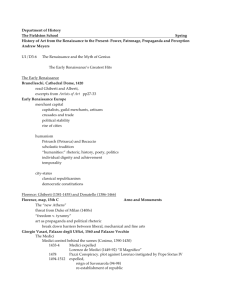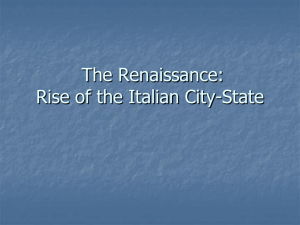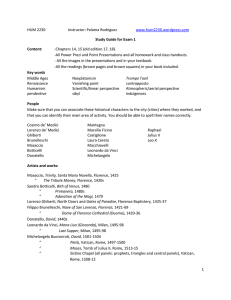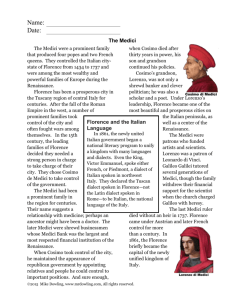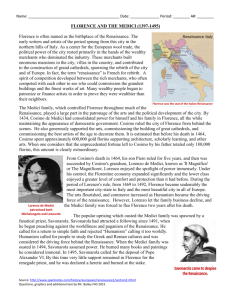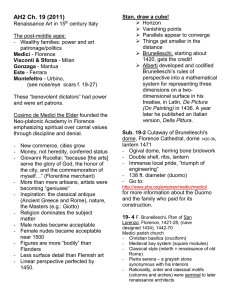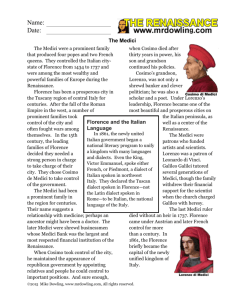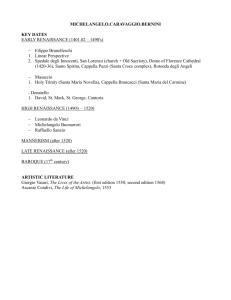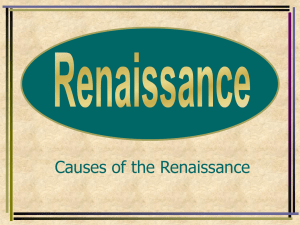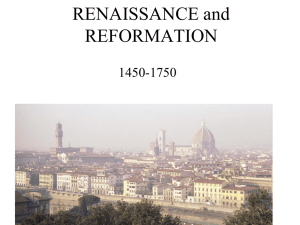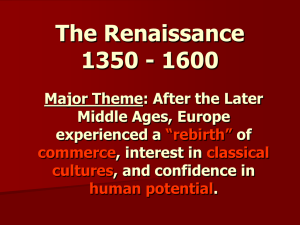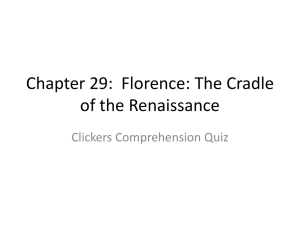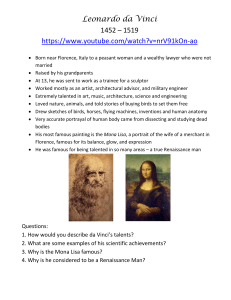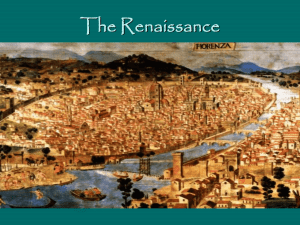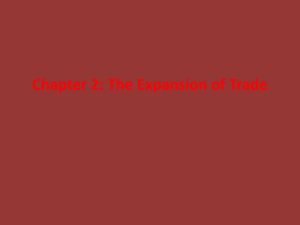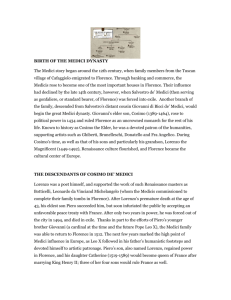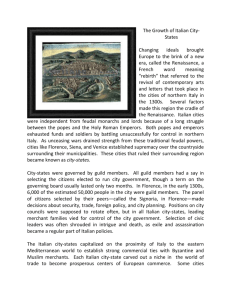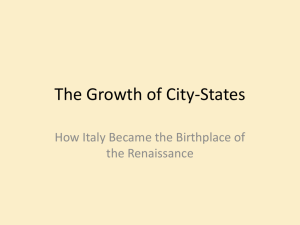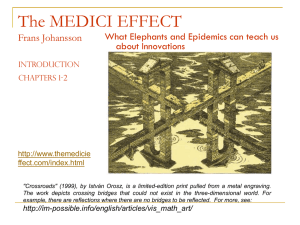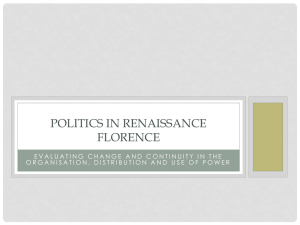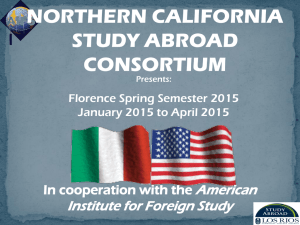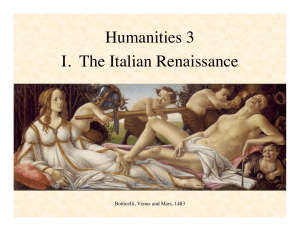Chapter 14 Section 1 notes
advertisement
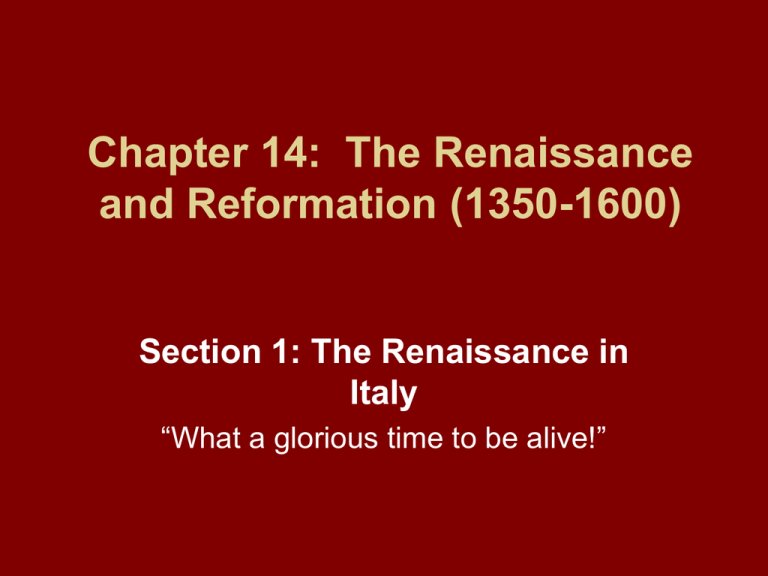
Chapter 14: The Renaissance and Reformation (1350-1600) Section 1: The Renaissance in Italy “What a glorious time to be alive!” Italian City-States • Renaissance = rebirth…of classical culture • Birthplace in Italy: Florence • Produced gifted poets, artists, architects, scholars and scientists • Eventually spread north: Flanders • Prosperous cities of trade – Florence, Milan, Venice, Genoa • Wealthy & powerful merchant class supported the arts and culture – patrons (supporters of the arts) • Education, individual achievement, curiosity (Copernicus/Galileo) and adventure (Columbus) stressed Medici family of Florence • built a powerful banking and merchant business (mined alum-chemical used in textile production/dying of wool) • Giovanni, Cosimo (Godfather) and Lorenzo “the Magnificent” (14491492) • 1434 onward: served as uncrowned rulers of Florence • Medici What was the Renaissance? • Most important change: the way people viewed themselves and the world • The human experience in the living world replaced the preoccupation with gaining salvation in the afterlife! • Preserving classical (Greek/Roman) heritage: Medieval monks/nuns & scholars copied manuscripts • Latin – survived as language of the Catholic Church and of educated people • Renaissance ideal = person with many talents (knows a great deal about many things: a Polymath) • Education, individual achievement, curiosity and adventurous spirit Humanism • intellectual movement based on the study of classical culture – did not focus only on religious issues! • Humanist scholars believed that education should stimulate creative powers of an individual. • They were collectors of classical manuscripts from church & monastery libraries. • Humanities: subjects taught in Greek and Roman schools – grammar, poetry, rhetoric, history, philosophy, etc. Francesco Petrarch (1304-1374) Father of Humanism • Humanist who searched for classical manuscripts (Homer, Virgil, Cicero, etc.) in monastery & church libraries. • He was also a devout Catholic. • wrote literature of his own (Sonnets to Laura) • April 8, 1341: crowned poet laureate in Rome on Easter Sunday • The laurel wreath was identified by Petrarch as being the symbol of literary and poetic immortality. • July 13, 1374: died with “a pen in his hand and Laura in his heart.” • Petrarch When Love within her lovely face appears now and again among the other ladies, as much as each is less lovely than she the more my wish I love within me grows. I bless the place, the time and hour of the day that my eyes aimed their sights at such a height, and say: 'My soul, you must be very grateful that you were found worthy of such great honour. From her to you comes loving thought that leads, as long as you pursue, to highest good, esteeming little what all men desire; there comes from her all joyous honesty that leads you by the straight path up to Heaven— already I fly high upon my hope.' A Golden Age in Arts • PATRONS: Popes, nobility and wealthy businessmen (Medici) supported the work of artists, architects, sculptors. • Isabella d’Este (1474-1539) from Mantua also patronized the arts. • She invited scholars, artists, sculptors & musicians to her city; was a Renaissance woman herself. • Isabella • Artists studied Greek & Roman works. • Religious figures (Mary & Jesus) were set against classical backgrounds • Humanist interest in individual achievement led to portraits of well-known people. Portraits of Isabella d’Este, 1st Renaissance Woman, by Leonardo Da’Vinci & Titian New Techniques • Artists revived lifelike, classical forms • studied human anatomy and live models – more accurate portrayal • used realism, linear perspective and shading • Architects rejected Gothic style – went back to columns, arches and domes Donatello di Betto Bardi (1386-1466) • Son of a Florentine woolcarder; apprentice to goldsmith Lorenzo Ghiberti at age 14 • Bronze David (1440s?) was 1st life-sized, free standing nude to be cast in bronze since classical times • Placed in the courtyard of the Medici palace for Lorenzo and Clarice Orsini’s wedding • Today it can be found in the Bargello Museum in Florence. Filippo Brunelleschi (1377-1446) “Father of Perspective” • Architect, engineer, goldsmith • Visited Rome with Donatello to study the ancient ruins • created the dome (14171434) of Florence Cathedral – based on the Pantheon in Rome • Used more than 4 million bricks • (1401-1403) Lost the competition to Ghiberti to design the bronze doors for the baptistery of the Florence Cathedral (Santa Maria del Fiore) • He is buried in the Florence Cathedral (Santa Maria del Fiore) Three Geniuses of Renaissance Art Self-Portraits of DaVinci & Raphael Leonardo DaVinci (1452-1519) • Born in Vinci, Italy (had 17 half-brothers & sisters!) • Many interests: botany, anatomy, optics, music, architecture, engineering, military • Genius for invention: placed sketches in notebooks: mirror writing • Dissected corpses to learn anatomy • Considered himself a painter • Invented sfumato: blending of light & shade • Famous works: Mona Lisa (1503-1506) & The Last Supper (1495-1498), Vitruvian Man/Proportions of Man (1487) • • • • • • Apprentice to Andrea del Verrochio (1470-1477) Served the Duke of Milan (Ludovico Sforza) from 1482-1499 – completed only 6 works in 17 years! 1513-1516: worked in Rome under Pope Leo X (Giovanni d’Medici) 1516-Premier Painter & Engineer and Architect of King Francis I in France. Died May 2, 1519 (67 yrs.) with his head in the hands of King Francis I Leonardo da Vinci Michelangelo Buonarotti (1475-1564) • Born March 6, 1475 in Caprese; 2nd of 5 brothers • His mother died when he was 6 years old • At age 13 he was apprenticed to Domenico Ghirlandaio and later lived with the Medici family in Florence. • Multi-talented genius: sculptor, engineer, painter, architect and poet • Considered himself a sculptor • Dissected corpses to learn anatomy • Famous works: Sculpture - Pieta (1499), David (1501-1504) • Painting - Sistine Chapel ceiling (1508-1512) & The Last Judgment (1536-1541) • Architecture – Dome of St. Peter’s (Rome) • • Died February 18, 1564 (89 yrs.) in Rome and is buried in Santa Croce Basilica in Florence In his will, he left "his soul to God, his body to the earth, and his material possessions to his nearest relations." Raphael Sanzio (1483-1520) • Italian painter, architect and draftsman from Urbino, Italy • Studied DaVinci & Michelangelo • • • • Both parents died when he was 8 years old He moved from Florence to Rome in 1508, where he ran a workshop until his death (37 yrs.) Painted frescoes in the Vatican Palace while Michelangelo was painting the Sistine Chapel ceiling Architect of the new St. Peter’s Basilica • Paintings portrayed the Madonna (Mary) & child (Jesus) • Famous work: The School of Athens- an imaginary gathering of philosophers & scientists – included faces of Michelangelo, DaVinci & himself • • • Died on April 6th (Good Friday & his birthday) of a possible fever (lasted 2 weeks) & wrong cure He was buried in the Pantheon after a grand funeral. "Here lies that famous Raphael by whom Nature feared to be conquered while he lived, and when he was dying, feared herself to die." Italian Renaissance Writers • “how-to”/handbooks became popular – to help ambitious men and women rise in the Renaissance world. Niccolo Machiavelli (1469-1527) • Served as a diplomat in Florence – observed kings/princes in courts during a time when the Medici were ousted from power (following Lorenzo’s death) • Lived during a time of religious fanaticism in Florence, the invasion of Italy by France and Spain and political turmoil • He was tortured an imprisoned when the Medici returned to power in 1512 – following the death of Savonarola • Saw himself as an enemy of oppression/corruption; wanted to earn the respect of the ruling Medici • wrote The Prince - a guide for rulers to help them gain & maintain power: It was dedicated to the deceased Lorenzo de Medici. • “The end justifies the means.” • “It is better to be feared than loved.” • “Machiavellian” = deceit in politics Baldassare Castiglione (1478-1529) • Italian courtier, diplomat, soldier and author • wrote The Book of the Courtier (1528)– describes manners, skills, learning, virtues of a courtier (aristocrat) • Ideal courtier = well-educated, well-mannered; master in music, poetry, history, sports, etc. • Ideal woman = graceful, kind, reserved & beautiful (on the outside!) • 108 editions published between 1528 – 1616 (in Spanish, German, French and English) • Died of a violent fever in Toledo, Spain on February 2nd Machiavelli (1469-1527) & Castiglione (1478-1529)
